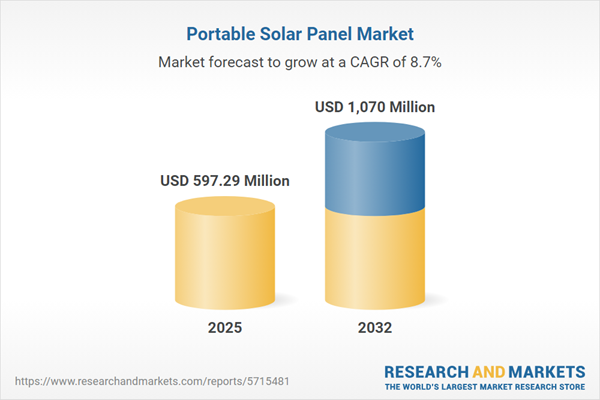Speak directly to the analyst to clarify any post sales queries you may have.
As senior leaders optimize continuity in unpredictable environments, portable solar panel solutions are gaining prominence for ensuring consistent power, operational agility, and smooth deployment across off-grid and remote business settings.
Market Snapshot: Portable Solar Panel Market
The portable solar panel market is progressing steadily, with a valuation of USD 549.78 million in 2024 and a projected increase to USD 597.29 million in 2025. Looking ahead, the market is expected to reach USD 1.07 billion by 2032.
This growth is propelled by the increasing demand for mobile energy that ensures stable off-grid operations where consistent power is critical. Organizations in diverse sectors—such as telecommunications, emergency services, marine, and construction—are integrating portable solar panel technology to secure energy access, bolster infrastructure, and support productivity where traditional grids are not available.Scope & Segmentation of the Portable Solar Panel Market
- Application: Portable solar panels address commercial, industrial, and residential needs, supporting activities in telecommunications, emergency services, logistics, remote project sites, recreational use, and backup power for urban residents and field teams.
- Type: The market comprises flexible monocrystalline and polycrystalline panels, foldable portable formats, and rigid high-efficiency models, designed to meet requirements for mobility, resilience, and both stationary and semi-permanent installation in varied settings.
- Wattage: Products in this sector cover a spectrum from compact, low-output chargers suitable for small teams, to high-capacity units capable of supporting critical infrastructure, ensuring coverage for a range of energy needs.
- Distribution Channel: Solutions are available through direct B2B sales, OEM partnerships, e-commerce platforms, and specialty retailers, enabling organizations to adapt purchasing according to project urgency and procurement frameworks.
- End User: The market serves professional campers, RV operators, emergency responders, defense forces, and telecommunications companies, all of whom rely on uninterrupted energy supplies in mobile, remote, or temporary scenarios.
- Geographic Coverage: Adoption is observed across the Americas, Europe, Asia-Pacific, Middle East, and Africa, each region demonstrating unique characteristics due to its specific regulatory environment, energy policies, and grid maturity.
- Key Companies Analyzed: Major and emerging vendors include Renogy Company Ltd., EcoFlow Technology Co., Ltd., GOAL ZERO, Inc., Jackery, Inc., Anker Innovations Limited, BioLite, Inc., AllPowers Technology Co., Ltd., ACEPEAK International Group, Voltaic Systems LLC, and Suaoki Industrial Co., Ltd., reflecting significant innovation and robust competition.
Key Takeaways for Senior Decision-Makers
- Deploying portable solar panels protects vital business functions in off-grid and remote locations, reducing exposure to disruptions due to power instability or limited access to infrastructure.
- Quick integration and robust component design allow for rapid deployment and adaptability, streamlining transitions and minimizing downtime across projects and industries.
- Sustainable and eco-friendly materials in product design support environmental, social, and governance (ESG) commitments, facilitating responsible sourcing and procurement decisions.
- Diverse sourcing options through digital platforms, B2B channels, and specialist outlets grant organizations flexibility to respond efficiently to shifting operational requirements and timelines.
- Collaborative relationships with manufacturers and logistics providers increase supply chain responsiveness, helping organizations remain agile as project scopes evolve.
- Industry-specific solutions offer targeted performance for verticals like telecom and construction, hence supporting uninterrupted business continuity in specialized operational environments.
Tariff Impact: Navigating Emerging Trade Dynamics
Anticipated U.S. tariffs on imported solar components, effective from 2025, are influencing procurement decisions and production strategies throughout the portable solar panel market. Many organizations are shifting toward localized manufacturing and reinforcing logistics capabilities to maintain project momentum while adjusting to evolving regulations. This evolving landscape may alter supplier relationships and necessitate procurement agility to effectively manage international trade risks.
Market Research Methodology & Data Sources
This portable solar panel market analysis utilizes interviews with industry executives, comprehensive market data review, and a detailed supply chain assessment. Insights from sector associations and regulatory stakeholders, together with scenario-based modeling, provide a solid foundation for the report’s projections and recommendations.
Why This Report Matters
- Presents actionable segmentation and a regional breakdown, enabling leaders to allocate resources and shape investment strategies as energy needs change.
- Supports continuous improvement in procurement and supply chain management, integrating portable solar solutions into sustainability and resilience planning.
- Helps organizations stay ahead of regulatory and industry shifts, equipping them to identify and pursue emerging opportunities efficiently.
Conclusion
Portable solar panels are an essential asset for maintaining operations in variable or challenging environments. This report provides leaders with the insights needed to align technology strategies with evolving organizational and market priorities.
Additional Product Information:
- Purchase of this report includes 1 year online access with quarterly updates.
- This report can be updated on request. Please contact our Customer Experience team using the Ask a Question widget on our website.
Table of Contents
3. Executive Summary
4. Market Overview
7. Cumulative Impact of Artificial Intelligence 2025
Companies Mentioned
The companies profiled in this Portable Solar Panel market report include:- Renogy Company Ltd.
- EcoFlow Technology Co., Ltd.
- GOAL ZERO, Inc.
- Jackery, Inc.
- Anker Innovations Limited
- BioLite, Inc.
- AllPowers Technology Co., Ltd.
- ACEPEAK International Group
- Voltaic Systems LLC
- Suaoki Industrial Co., Ltd.
Table Information
| Report Attribute | Details |
|---|---|
| No. of Pages | 182 |
| Published | October 2025 |
| Forecast Period | 2025 - 2032 |
| Estimated Market Value ( USD | $ 597.29 Million |
| Forecasted Market Value ( USD | $ 1070 Million |
| Compound Annual Growth Rate | 8.7% |
| Regions Covered | Global |
| No. of Companies Mentioned | 11 |









